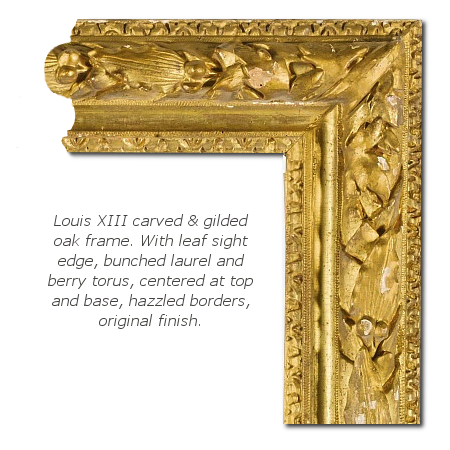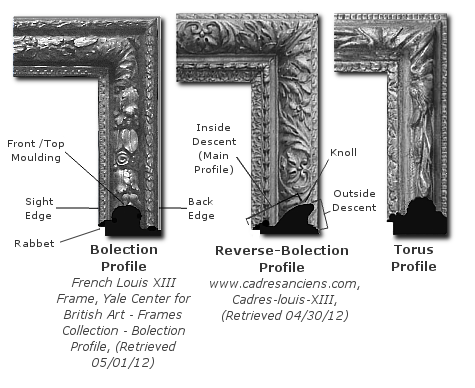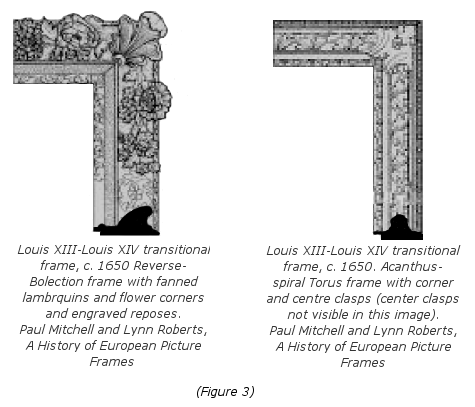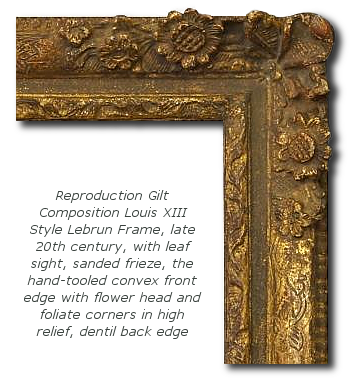"A Brief History of Frames - Baroque: Louis XIII"
Author: John O'Keefe Jr.(© Copyright 2012, John O'Keefe Jr.) Publisher: Painting Frames Plus
(Published Date: 2012)
(Modified Date: 2016)
Baroque: Period: 1610-1643
Baroque is an artistic style that started in Italy in the 1600s and continued to be in fashion until the late 1700s. Baroque influence and style spread from Italy to most of Europe and is known for its "exaggerated motion and clear, easily interpreted detail to produce drama, tension, exuberance, and grandeur in sculpture, painting, architecture, literature, dance, and music." [1] The word "baroque" was applied to this period in history by critics of the late nineteenth century.
French Baroque:
Frames developed in France during the Baroque period can be categorized into several distinct styles: Louis XIII, Louis XIV, Regency (Phillippe II), Louis XV (Rococo), Louis XVI (Neoclassical) and Empire (Neoclassical). The dating of individual frames does not always coincide with the reigns that they take their names from. For example, most Louis XIII frames were made "in the second half of the 17th century, though Louis XIII died in 1643." [2] Also, there are identifiable "transitional" styles between the main style groups.
Louis XIII Frame:
"Louis XIII frames are characterized by a close bonding of ornamentation to the profile and straight rails with decorative borders. Three mouldings make up the profiles: an inner, middle and outer. Leaf, branch and flower elements are tied together in a web-like pattern on the surface. The most common organic motifs are [acanthus,] oak or laurel leaves bordered by ribbons, husks or leaf tips. The general style came out of French architectural Baroque ceiling and door frame design. Variations of this style can be seen on frames of all sizes and were used until the end of the 1600's. They represented the first national standard for pattern design." [3]

Typical Louis XIII frames use what is called a "running pattern" design due to the absence of accented corner and/or center cartouches. Common profiles are the Bolection, Reverse-Bolection and Torus. When the "front moulding" (also called "top moulding") is located closer to the frame's "back edge" the profile is known as a Reverse-Bolection profile, and when it is closer to the "sight edge" its a Bolection profile. The "knoll" describes the rounded summit of the profile, or the area of the frame closest to the viewer when the frame is hanging on a wall.

Louis XIII / Louis XIV "Transitional" Frame:
The Louis XIII style overlapped the period of Louis XIV (1643-1715) and resulted in two transitional styles characterized by accented corners and/or centers. The more common type has raised corners with a number of flowers and often includes the sunflower, that was symbolic of Louis XIV, known as the Sun King. The second style is architectural in feel with a torus section on a flat moulding bordered by panels and leaf tips. The leaves are not bunched together as in the Louis XIII frames, but carved in a spiral pattern. The corners and centers are accented by cartouches which usually do not protrude beyond the outer edge of the moulding. [3]

The first style transitional frame, also known as the Louis XIII Flower-Corner frame, was produced in the latter part of Louis XIII reign (1610-1643) through the Louis XIV reign (1643-1715). It has been debated if the style should be categorized as a Louis XIII, Louis XIII/XIV "transitional", or a Louis XIV frame.
Historically, the origins of the design has been traced to Italy. Maria de Medici, acting as Regent during the minority of Louis XIII (1601-1617), contributed stylistic influence to art, architecture and to frame design. [4]
This type of French Baroque flower corner frame with fanned lambrequins is also known as the "Le Brun" frame after the artist Charles LeBrun. Charles LeBrun (1619 -1690) became the first Painter to King Louis XIV and has been credited as the originator of the style known as Louis XIV. Early in his career he produced works for Louis XIII, Pope Urban VII and the Queen Mother Anne of Austria.

Mark Guthrie described some of the defining features of this style: Projecting carved corner activity consisting of: "Fanned Lambrequin" corners (a borrowing from the plumed scarf from a knight's helmet); Asymmetrical floral garlands on either side of the corner (often containing one sunflower-contributing to the "transitional" attribution argument); and clean reposes (the space between the corners) or reposes with finely inscribed leaf and tendril design. Aesthetically, pronounced corner activity on a frame of this style created a diagonal interplay with the composition of the painting it would house ... Originally, the design was most commonly used for portraits. [4]
(...View More Louis XIII / XIV Transitional Frames)References:
- Paul Fargis, The New York Public Library Desk Reference (third ed.). New York: Macmillan General Reference. pp. 262. ISBN 0-02-862169-7. (1998)
- www.abemunn.com, Louis XIII Frame History, (Retrieved 04-29-12)
- Diane Day, A Survey of Frame History, Part III: Louis XIII and Louis XIV Frames, (Oct. 1998)
- Mark Guthrie, Style Snapshot: A look at a frame, its characteristic, and history, e.g. "LeBrun Frame", (July 2004)
Bibliography:
- Paul Fargis, The New York Public Library Desk Reference (third ed.). New York: Macmillan General Reference. pp. 262. ISBN 0-02-862169-7. (1998)
- www.abemunn.com, Louis XIII Frame History, (Retrieved 04/29/12)
- Huge Glover, A Description of 19th-century American Gilded Picture Frames and an Outline of Their Modern Use and Conservation
- Diane Day, A Survey of Frame History, Part III: Louis XIII and Louis XIV Frames, (Oct. 1998)
- Paul Mitchell and Lynn Roberts, A History of European Picture Frames
- www.pictureframingmagazine.com, An Evolution of Frame Design, 1400-2000, (July 2000)
- Mark Guthrie, Style Snapshot: A look at a frame, its characteristic, and history, e.g. "LeBrun Frame", (July 2004)
- Peter Werkhoven, Style Snapshot: A look at a frame, its characteristic, and history, e.g. "Louis XIII/XIV Transitional Frame", (May 2006)